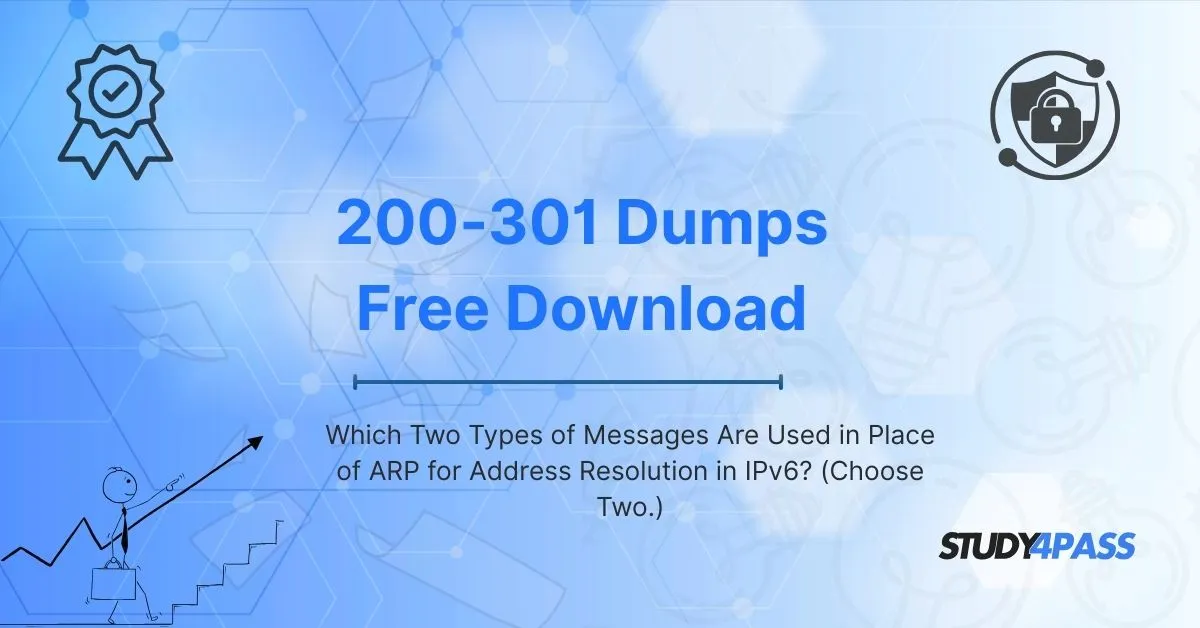Introduction To 200-301 Exam Prep Practice Tests Free Download
In the world of networking, IPv6 has brought significant improvements over IPv4, including a more efficient address resolution mechanism. While IPv4 relies on Address Resolution Protocol (ARP) to map IP addresses to MAC addresses, IPv6 replaces ARP with a more streamlined approach using ICMPv6 Neighbor Discovery Protocol (NDP).
If you're preparing for the CCNA 200-301 exam, understanding IPv6 address resolution is crucial. Many students look for "200-301 Exam Prep Practice Tests Free Download" resources, but relying solely on exam prep practice test isn't the best strategy. Instead, mastering core concepts like IPv6 neighbor discovery will help you succeed.
In this blog post, we’ll explore:
Why IPv6 replaces ARP
The two types of messages used in IPv6 for address resolution
- How these messages work
- Why Study4Pass is the best resource for CCNA 200-301 preparation
- Why IPv6 Replaces ARP
In IPv4, ARP broadcasts requests across the local network to find the MAC address associated with an IP. While this works, it has some inefficiencies:
- Broadcast traffic floods the network, consuming bandwidth.
- No built-in security, making ARP susceptible to spoofing attacks.
- IPv6 eliminates ARP by using ICMPv6 Neighbor Discovery Protocol (NDP), which is more efficient and secure.
The Two Messages Used in IPv6 for Address Resolution
Instead of ARP, IPv6 uses two ICMPv6 messages:
1. Neighbor Solicitation (NS) Messages
Purpose: Used by a host to discover the MAC address of a neighbor (similar to an ARP request).
How It Works:
A device sends an NS message to the solicited-node multicast address of the target IPv6 address.
The message includes the sender’s IPv6 and MAC address.
Only the intended host (with the target IPv6 address) processes the request.
2. Neighbor Advertisement (NA) Messages
Purpose: The response to an NS message (similar to an ARP reply).
How It Works:
The target device replies with Exam Prep Practice Test, providing its MAC address.
This message is sent unicast back to the requester.
Comparison with ARP
Feature IPv4 (ARP) IPv6 (NDP)
Message Type ARP Request/Reply Neighbor Solicitation/Advertisement
Traffic Type Broadcast Multicast (more efficient)
Security Vulnerable to spoofing Supports Secure Neighbor Discovery (SEND)
How IPv6 Address Resolution Works Step-by-Step
Let’s break down the process:
1. Host A wants to communicate with Host B (IPv6 address: 2001:db8::1).
2. Host A checks its neighbor cache (like ARP cache in IPv4).
If no entry exists, it sends a Neighbor Solicitation (NS) message.
3. The NS is sent to the solicited-node multicast address (FF02::1:FF00:1).
Only Host B (with the matching IPv6) processes it.
4. Host B responds with a Neighbor Advertisement (NA) message.
This contains Host B’s MAC address.
5. Host A updates its neighbor cache and proceeds with communication.
This process is faster and more secure than ARP.
Why Study4Pass is the Best for CCNA 200-301 Preparation
If you're searching for "200-301 exam prep practice test free download", be cautious—many exam prep practice test contain outdated or incorrect information. Instead, Study4Pass offers:
- Up-to-date CCNA 200-301 Certification
- Practice tests with real exam-like questions
- Detailed explanations (like this blog post!)
- Hands-on labs for practical learning
Instead of memorizing exam prep practice test, master the concepts with Study4Pass and pass your exam confidently!
Conclusion
IPv6 replaces ARP with Neighbor Solicitation (NS) and Neighbor Advertisement (NA) messages, making address resolution more efficient and secure. Understanding these concepts is essential for the CCNA 200-301 exam.
Special Discount: Offer Valid For Limited Time “200-301 Exam Prep Practice Tests”
Sample Questions for Cisco 200-301 Exam Prep Practice Test
Actual exam question from Cisco's 200-301 Exam
Which of the following is the most reliable source for CCNA 200-301 exam preparation?=
A) 200-301 exam prep practice test free download from unknown websites
B) Official Cisco Learning Materials
C) Brain exam prep practice test with outdated questions
D) Unverified PDFs from forums


